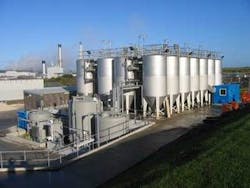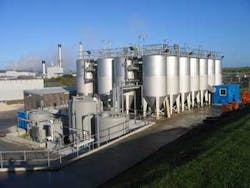Purifying River Water for Cardboard Manufacture with DynaSand
Iggesund Paperboard uses some 22 megaliters of raw water per day in the manufacture of 260,000 British tons of folding boxboard at its Workington plant in the United Kingdom. To ensure continuity of high quality water supply, Iggesund decided to manage the treatment on its own site, using Hydro International’s DynaSand® filtration plant to automatically handle the large volumes within a very small footprint and with minimal supervision.
Alan Brown, contracts and supply manager at Iggesund, explains: “The source of process water is the River Derwent, which is a typical spate river; at low flow levels it’s pretty clean but, when it runs high, carries high amounts of suspended solids. Our objective is to have water approaching potable quality all year round, and Hydro’s DynaSand units and lamella plate clarifier have consistently and successfully delivered that since their commissioning in the spring of 2006, with minimal maintenance requirements.
“The river water is extracted by a utilities company from the river and pumped to large underground reservoirs,” he added. “It then flows under gravity to the mill where the underground pipeline passes close to our wastewater plant, so it made sense to locate the raw water treatment plant there. Although the project required major civil work including cutting back into the hill side, the vertical configuration of the DynaSand enabled us to locate all 28 units plus the clarifier and dosing equipment there.”
The process takes the raw water, doses it with a PAC flocculant, which enables the filtration units operating in parallel, to filter out the suspended solids. pH is corrected and small dose of hydrochlorite sterilizes the water before it enters the board mill. The backwash water from the filter is passed through a lamella clarifier to remove solids before this flow is returned and mixed with the raw water supply. This ensures only a minimal amount of the water is wasted through the process. Apart from topping off the chemicals, there’s very little intervention. The plant is automatic/PLC-controlled, and this enabled a remote control station in the existing control room for the wastewater treatment operator, Brown said.
The filtration units comprise a sand filter bed held within a hopper into which water, pre-dosed with coagulant, is pumped via a manifold to deep within the sand. The water flows up through the sand bed, where solids are trapped on grains of sand, into open space above the sand, and cleansed water exits via a weir at the top to a buffer tank.
Sand containing the entrapped solids is continuously air lifted from the bottom of the hopper, washed by a turbulent mixing action, and the clean sand allowed to return to the sand bed at the top to ensure a circular cleansing cycle. The wash water with separated solids is discharged separately for treatment. The filtration plant is packaged with pumps, flow meters and dosing equipment, in a compact installation.
The Hydro lamella plate clarifier occupies an area as little as 10% of that required by an equivalent settling pond. In it, a gentle upflow over incline plates via a patented flow control system allows settled sludges to fall to the bottom of the separator and clarified water to leave at the top.
Portland, ME-based Hydro International, which has offices also in the UK and Ireland, offers solutions for controlling the quantity and improving the quality of water, wastewater and stormwater for industrial, construction and municipal sectors. Its UK Water & Wastewater Division is in Ely, Cambridgeshire, England. Contact: 207-756-6200 or www.hydro-international.biz

